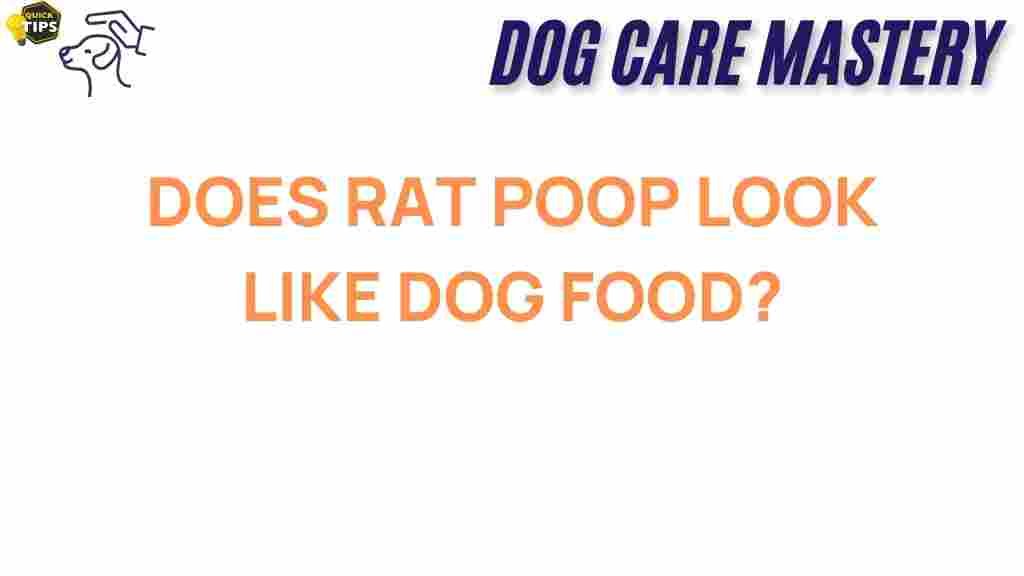Unraveling the Mystery: Does Rat Poop Resemble Dog Food?
When it comes to pest control and maintaining a clean home, understanding the signs of rodent infestations is crucial. One of the most alarming indicators is the presence of rat poop. But what exactly does rat poop look like, and could it possibly resemble something harmless, like dog food? This article delves deep into the characteristics of rat droppings, their potential resemblance to dog food, and how to identify them to ensure your home remains rat-free.
What is Rat Poop?
Rat poop, or rat droppings, is a common sign of a rodent presence in your home or property. Understanding its characteristics can help you distinguish it from other types of waste. Here’s what you need to know:
- Size: Rat droppings are typically about 1/2 inch to 3/4 inch long.
- Shape: They are oval or cylindrical and have pointed ends.
- Color: Fresh rat droppings are dark brown or black, while older droppings may lighten in color as they dry out.
- Texture: They have a firm texture but can crumble if disturbed.
Does Rat Poop Resemble Dog Food?
The question arises: does rat poop resemble dog food? At first glance, some may argue that the dark, cylindrical shape of rat droppings might be confused with certain types of dry dog food. However, a closer inspection reveals distinct differences.
Key Differences Between Rat Poop and Dog Food
Here are some important points to consider:
- Color: While both can be dark, dog food may have a more varied color palette depending on the brand and ingredients.
- Shape and Size: Rat droppings are more uniform in size and shape compared to the irregular shapes of dog food pieces.
- Texture: Rat poop is harder and can crumble, while dog food typically remains intact unless it has been softened.
- Odor: Rat droppings emit a strong, unpleasant odor, especially when fresh, whereas dog food has a more neutral or appetizing scent.
Identifying Rat Poop: A Step-by-Step Guide
To determine whether you are dealing with rat poop or dog food, follow these steps:
- Step 1: Look for the location of the droppings. Rat poop is often found near nesting areas, food sources, or along pathways.
- Step 2: Observe the size and shape. Use a ruler or measuring tape to confirm the length of the droppings.
- Step 3: Check the texture. Gently press on the droppings to see if they crumble or remain solid.
- Step 4: Detect the smell. If you notice a strong, musky odor, it’s likely rat droppings.
- Step 5: Compare with known samples. If possible, compare the droppings to a sample of dog food.
Health Risks Associated with Rat Poop
Identifying rat poop is crucial not just for pest control but also for health reasons. Rat droppings can carry several diseases, including:
- Hantavirus: Can be contracted through inhalation of dust contaminated with rat droppings.
- Leptospirosis: Can be transmitted through contact with rat urine or droppings.
- Salmonella: May result from ingesting food contaminated by rat feces.
Troubleshooting: What to Do If You Find Rat Poop
If you discover rat droppings in your home, take the following steps:
- Do Not Panic: Understand that finding rat poop doesn’t mean your home is overrun.
- Wear Protective Gear: Before cleaning, wear gloves and a mask to avoid direct contact and inhalation.
- Clean Up Safely: Use a disinfectant spray on the droppings before cleaning to reduce the risk of disease. Use a paper towel to pick them up and dispose of them in a sealed bag.
- Inspect the Area: Look for signs of nests or entry points where rats might be entering your home.
- Contact Pest Control: If the infestation seems significant, it may be time to contact a professional pest control service.
Preventing Future Rat Infestations
Once you’ve dealt with the immediate issue of rat poop, it’s essential to take steps to prevent future infestations:
- Seal Entry Points: Check for gaps or holes in walls, doors, and windows and seal them properly.
- Store Food Properly: Keep food in airtight containers to avoid attracting rodents.
- Maintain Cleanliness: Regularly clean your home, especially kitchens and dining areas, to remove potential food sources.
- Trim Vegetation: Keep shrubs and trees trimmed back from the house to reduce hiding spots for rats.
Conclusion
In conclusion, while the idea that rat poop resembles dog food may seem plausible at first glance, a thorough examination reveals significant differences. Understanding what rat poop looks like—its size, shape, texture, and smell—is essential for effective pest control and maintaining a healthy environment in your home. If you suspect a rat infestation, follow the steps outlined in this article to identify and safely remove any droppings. For more information on pest control, visit this resource, and consider consulting a professional to ensure your home remains safe and rat-free.
Remember, prevention is always better than cure. By taking proactive measures and staying vigilant, you can protect your home from unwanted rodent visitors and the health risks they bring.
This article is in the category Safety and created by dogcaremastery Team
